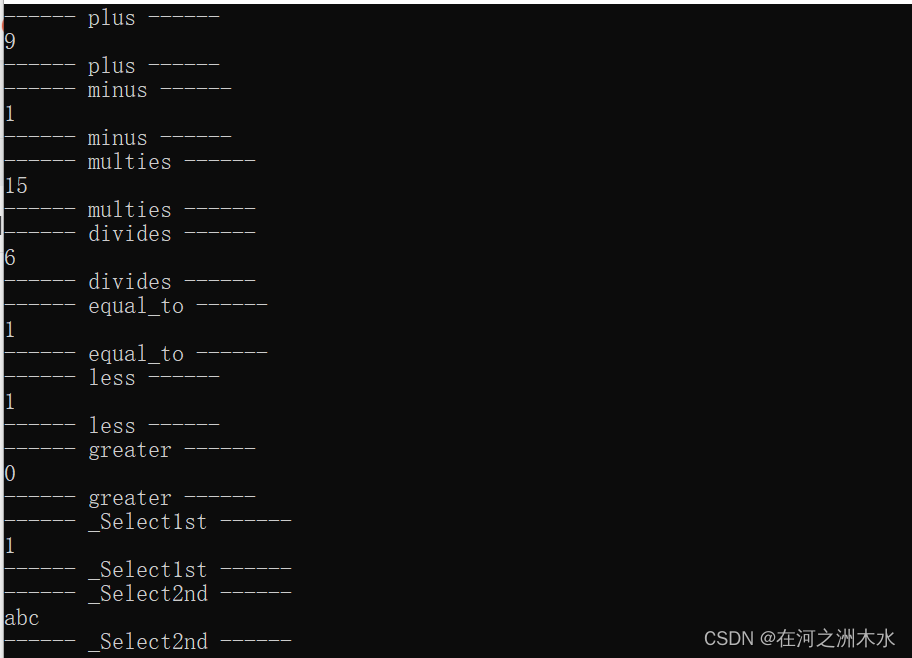本文主要是介绍C++ 中的仿函数 functor,希望对大家解决编程问题提供一定的参考价值,需要的开发者们随着小编来一起学习吧!
一 仿函数的概念
1. 定义
仿函数(functor)是一种使用上像函数的类,其本质是一个实现了 operato() 函数的类,这种类就有了类似于函数一样的使用行为,这就是仿函数的类。
仿函数在 C++ STL标准库中被大量使用。
2. 特点
1. 仿函数是一个类,不是一个函数
2. 仿函数的类需要重载 operator() 函数,以此拥有函数的行为
二 STL 中常见的 仿函数介绍
1. 基类
1.1 unary_function
/*** This is one of the @link functors functor base classes@endlink.*/template<typename _Arg, typename _Result>struct unary_function{/// @c argument_type is the type of the argumenttypedef _Arg argument_type; /// @c result_type is the return typetypedef _Result result_type; };作为拥有一个输入参数的仿函数常用基类,该类主要回答了两个问题:
1. 该仿函数类的输入参数是什么类型:argument_type
2. 该仿函数类的返回参数是什么类型: result_type
1.2 binary_function
/*** This is one of the @link functors functor base classes@endlink.*/template<typename _Arg1, typename _Arg2, typename _Result>struct binary_function{/// @c first_argument_type is the type of the first argumenttypedef _Arg1 first_argument_type; /// @c second_argument_type is the type of the second argumenttypedef _Arg2 second_argument_type;/// @c result_type is the return typetypedef _Result result_type;};作为拥有两个输入参数的仿函数常用基类,该类主要回答了两个问题:
1. 该仿函数类的输入参数是什么类型:first_argument_type 与 second_argument_type
2. 该仿函数类的返回参数是什么类型: result_type
2. STL 中常见仿函数
2.1 plus
/// One of the @link arithmetic_functors math functors@endlink.template<typename _Tp>struct plus : public binary_function<_Tp, _Tp, _Tp>{_Tpoperator()(const _Tp& __x, const _Tp& __y) const{ return __x + __y; }};2.2 minus
/// One of the @link arithmetic_functors math functors@endlink.template<typename _Tp>struct minus : public binary_function<_Tp, _Tp, _Tp>{_Tpoperator()(const _Tp& __x, const _Tp& __y) const{ return __x - __y; }};2.3 multiplies
/// One of the @link arithmetic_functors math functors@endlink.template<typename _Tp>struct multiplies : public binary_function<_Tp, _Tp, _Tp>{_Tpoperator()(const _Tp& __x, const _Tp& __y) const{ return __x * __y; }};2.4 divides
template<typename _Tp>struct divides : public binary_function<_Tp, _Tp, _Tp>{_Tpoperator()(const _Tp& __x, const _Tp& __y) const{ return __x / __y; }};2.5 equal_to
/// One of the @link comparison_functors comparison functors@endlink.template<typename _Tp>struct equal_to : public binary_function<_Tp, _Tp, bool>{booloperator()(const _Tp& __x, const _Tp& __y) const{ return __x == __y; }};2.6 less
/// One of the @link comparison_functors comparison functors@endlink.template<typename _Tp>struct less : public binary_function<_Tp, _Tp, bool>{booloperator()(const _Tp& __x, const _Tp& __y) const{ return __x < __y; }};2.7 greater
/// One of the @link comparison_functors comparison functors@endlink.template<typename _Tp>struct greater : public binary_function<_Tp, _Tp, bool>{booloperator()(const _Tp& __x, const _Tp& __y) const{ return __x > __y; }};2.8 _Select1st
template<typename _Pair>struct _Select1st: public unary_function<_Pair, typename _Pair::first_type>{typename _Pair::first_type&operator()(_Pair& __x) const{ return __x.first; }const typename _Pair::first_type&operator()(const _Pair& __x) const{ return __x.first; }};2.9 _Select2nd
template<typename _Pair>struct _Select2nd: public unary_function<_Pair, typename _Pair::second_type>{typename _Pair::second_type&operator()(_Pair& __x) const{ return __x.second; }const typename _Pair::second_type&operator()(const _Pair& __x) const{ return __x.second; }};3. 使用例子
#include<algorithm>
#include<iostream>int main()
{// 1. plusstd::cout << "------ plus ------" << std::endl;std::vector<int> vec = {1, 3, 5};std::plus<int> pl;int init = 0;int res1 = std::accumulate(vec.begin(), vec.end(), init, pl);std::cout << res1 << std::endl;std::cout << "------ plus ------" << std::endl; // 9// 2. minusstd::cout << "------ minus ------" << std::endl;init = 10;std::minus<int> mis;int res2 = std::accumulate(vec.begin(), vec.end(), init, mis);std::cout << res2 << std::endl; // 1std::cout << "------ minus ------" << std::endl;// 3. multiesstd::cout << "------ multies ------" << std::endl;init = 1;std::multiplies<int> multiply;int res3 = std::accumulate(vec.begin(), vec.end(), init, multiply);std::cout << res3 << std::endl; // 15std::cout << "------ multies ------" << std::endl;// 4. dividesstd::cout << "------ divides ------" << std::endl;init = 90;std::divides<int> divid;int res4 = std::accumulate(vec.begin(), vec.end(), init, divid);std::cout << res4 << std::endl; // 6std::cout << "------ divides ------" << std::endl;// 5. equal_tostd::cout << "------ equal_to ------" << std::endl;std::pair<int, std::string> pair1 = std::make_pair(1, "abc");std::pair<int, std::string> pair2 = std::make_pair(2, "abc");std::equal_to<std::string> equal;std::_Select2nd<std::pair<int, std::string>> second_argu;std::cout << equal(second_argu(pair1), second_argu(pair2)) << std::endl;// 1std::cout << "------ equal_to ------" << std::endl;// 6. lessstd::cout << "------ less ------" << std::endl;std::less<int> less;std::cout << less(3, 6) << std::endl; // 1std::cout << "------ less ------" << std::endl;// 7. greaterstd::cout << "------ greater ------" << std::endl;std::greater<int> greater;std::cout << greater(3, 6) << std::endl; // 0std::cout << "------ greater ------" << std::endl;// 8. _Select1ststd::cout << "------ _Select1st ------" << std::endl;std::pair<int, std::string> pair3 = std::make_pair(1, "abc");std::_Select1st<std::pair<int, std::string>> select1st;std::cout << select1st(pair3) << std::endl; // 1std::cout << "------ _Select1st ------" << std::endl;// 9. _Select2ndstd::cout << "------ _Select2nd ------" << std::endl;std::pair<int, std::string> pair4 = std::make_pair(1, "abc");std::_Select2nd<std::pair<int, std::string>> select2nd;std::cout << select2nd(pair3) << std::endl; // abcstd::cout << "------ _Select2nd ------" << std::endl;return 0;
}
输出:

这篇关于C++ 中的仿函数 functor的文章就介绍到这儿,希望我们推荐的文章对编程师们有所帮助!


